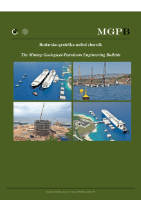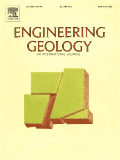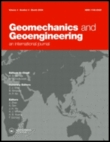
Geam-Geoingegneria Ambientale e Mineraria-Geam-Geoengineering Environment and Mining
Scope & Guideline
Pioneering research at the intersection of earth science and sustainability.
Introduction
Aims and Scopes
- Environmental Risk Management:
Research on methodologies and practices for assessing and managing risks associated with geological and environmental factors, particularly in mining and infrastructure contexts. - Innovative Engineering Solutions:
Development and evaluation of new technologies and engineering methods to address challenges in environmental protection, mining operations, and geological conservation. - Geological and Environmental Conservation:
Studies focused on the preservation of geological formations and cultural heritage, emphasizing the importance of sustainable practices in environmental engineering. - Impact of Climate Change on Geotechnical Engineering:
Investigations into how climate change affects geological stability, resource management, and infrastructure resilience. - Sustainable Resource Management:
Exploration of strategies for the sustainable extraction and use of natural resources, including the evaluation of alternative materials and methods.
Trending and Emerging
- Climate Resilience and Adaptation Strategies:
Growing emphasis on research that addresses how engineering and geological practices can adapt to the impacts of climate change, ensuring resilience in infrastructure and natural systems. - Use of Technology in Environmental Monitoring:
Increasing focus on innovative technologies, such as drones and GIS, for monitoring environmental changes and assessing geological risks, highlighting the integration of technology in traditional fields. - Sustainable Mining Practices:
A surge in studies aimed at developing sustainable mining strategies that minimize environmental impact while optimizing resource extraction, reflecting a shift towards responsible mining. - Interdisciplinary Approaches to Environmental Issues:
Emerging research that combines insights from various disciplines, including ecology, engineering, and social sciences, to address complex environmental challenges holistically. - Impact of Urbanization on Geological Systems:
Research exploring the implications of urban development on geological stability and resource management, recognizing the interplay between urbanization and geotechnical engineering.
Declining or Waning
- Traditional Quarrying Practices:
Research related to conventional quarrying methods, which appears to be declining as the focus shifts towards more sustainable and innovative practices. - General Geological Studies:
Broader geological research that lacks a specific application or focus, which may be overshadowed by more targeted studies addressing pressing environmental and engineering challenges. - Non-innovative Risk Assessment Techniques:
Traditional risk assessment methods that do not incorporate modern technological advancements or interdisciplinary approaches are becoming less common as newer methodologies gain favor.
Similar Journals

Rudarsko-Geolosko-Naftni Zbornik
Navigating the Complexities of Earth's ResourcesRudarsko-Geolosko-Naftni Zbornik, the esteemed journal published by the University of Zagreb's Faculty of Mining, Geology and Petroleum Engineering, serves as a vital platform for advancing knowledge in the fields of Earth sciences, energy, and geology. With an ISSN of 0353-4529 and an E-ISSN of 1849-0409, this open-access journal has been disseminating high-quality research since 1989, contributing significantly to scientific discourse in Croatia and beyond. As of 2023, it holds an impressive categorization in various quartiles, notably achieving Q2 in Earth and Planetary Sciences and Q3 in several related domains, showcasing its relevance and impact within the academic community. The journal's commitment to quality is reflected in its Scopus rankings, placing it in competitive positions across diverse disciplines. Researchers, professionals, and students alike will find invaluable resources and insights that foster innovation and collaboration in their respective fields, making Rudarsko-Geolosko-Naftni Zbornik an essential read for those dedicated to exploring the complexities of natural resources and environmental challenges.

ENGINEERING GEOLOGY
Advancing the Intersection of Geology and EngineeringENGINEERING GEOLOGY, published by Elsevier, is a leading journal in the fields of Geology and Geotechnical Engineering, recognized by its prestigious Q1 ranking in both categories for 2023. With a deep focus on the application of geological principles to engineering practices, this journal plays a vital role in advancing knowledge and methodologies that enhance infrastructure development and environmental sustainability. Operating since 1965, the journal disseminates high-quality research, offering insights that foster innovation in geotechnical assessments and geological hazard evaluation. Researchers and professionals benefit from its rigorous peer-review process and impactful studies, bolstered by a strong Scopus ranking - #4 in Geology and #3 in Geotechnical Engineering, both placing it in the top 2% of its field. Although there is no Open Access option available, the journal facilitates significant academic discourse, making it an essential resource for anyone involved in the intersection of geology and engineering.

Boletin de Ciencias de la Tierra
Unveiling Insights into Earth’s Complex SystemsBoletin de Ciencias de la Tierra is a distinguished open-access journal dedicated to the field of Earth and Planetary Sciences, published by the Universidad Nacional de Colombia, Sede Medellín. Since its transition to open access in 2006, it has become an essential platform for disseminating high-quality research that addresses critical geological and environmental issues pertinent to Latin America and beyond. With an ISSN of 0120-3630 and an E-ISSN of 2357-3740, the journal aims to promote scientific dialogue and share innovative findings in various areas including geology, geochemistry, and environmental sciences. Although it currently holds a Scopus rank of #184 in the General Earth and Planetary Sciences category, indicating a percentile of only 5, Boletin de Ciencias de la Tierra is committed to fostering a rich academic discourse and enhancing the visibility of scholarly works. Situated in Medellín, Colombia, the journal serves as a vital resource for researchers, professionals, and students looking to explore advancements and participate in the global conversation on Earth sciences.

Journal of Mining and Environment
Exploring the intersection of geology and ecological integrity.Journal of Mining and Environment, published by Shahrood University of Technology, is a pivotal peer-reviewed journal dedicated to advancing the fields of geochemistry, petrology, geophysics, geotechnical engineering, and pollution studies. With its ISSN 2251-8592 and E-ISSN 2251-8606, this journal aims to disseminate significant research findings that address critical environmental challenges associated with the mining industry. Operating out of Iran, the journal has quickly established itself in the academic arena, achieving a Q3 quartile ranking across multiple categories in 2023, highlighting its contribution to the scientific community's understanding of mining-related environmental impacts. Accessible to researchers, professionals, and students, the journal emphasizes open dialogue and interdisciplinary collaboration, focusing on innovative methodologies and sustainable practices that can shape the future of mining and environmental stewardship. With a commitment to quality and relevance, the Journal of Mining and Environment is an essential resource for anyone engaged in the crucial intersection of mining processes and environmental integrity, encouraging submissions that push the boundaries of current knowledge.

Mine Water and the Environment
Transforming mine water research into actionable solutions.Mine Water and the Environment is a leading peer-reviewed journal published by Springer Heidelberg, dedicated to advancing the understanding of the complex interactions between mining activities and water resources. With an ISSN of 1025-9112 and an E-ISSN of 1616-1068, this journal serves as a vital platform for researchers, professionals, and students in the fields of Geotechnical Engineering, Engineering Geology, and Water Science and Technology. Positioned in the Q2 category for both relevant quartiles in 2023, it showcases high-impact research that addresses critical issues associated with mine water management, treatment, and its environmental implications. Spanning a publication history from 1991 to 2024, the journal not only highlights contemporary challenges in mine-related water issues but also fosters interdisciplinary collaboration to promote sustainable practices in mining. Situated in Heidelberg, Germany, this journal strives to provide open discussion and innovative solutions for the pressing environmental challenges posed by mining activities, making it an essential resource for anyone invested in the sustainability of our water resources.

Geomechanics and Geoengineering-An International Journal
Driving Progress in Soil and Rock MechanicsGeomechanics and Geoengineering-An International Journal, published by Taylor & Francis Ltd, serves as a prominent platform for the dissemination of innovative research and advancements in the fields of Geotechnical Engineering and Engineering Geology. With an ISSN of 1748-6025 and E-ISSN of 1748-6033, this journal has established itself as a critical resource within its category, ranking in the Q2 quartile according to the 2023 metrics and positioning itself in the top 38% of the Scopus rankings for Earth and Planetary Sciences. Geomechanics and Geoengineering encompasses a diverse range of topics, including but not limited to soil mechanics, foundation engineering, rock mechanics, and environmental geotechnics, ultimately aiming to advance both theoretical and practical knowledge in these vital areas. This journal not only highlights pioneering research but also facilitates a platform for academia and industry practitioners to collaborate and exchange ideas. While it does not offer open access, it remains a valuable resource for institutions and individuals committed to enhancing their expertise in the geotechnical domain. With convergence years spanning from 2006 to 2024, this journal is equipped to significantly contribute to the evolving landscape of geomechanical research.

Proceedings of the Tula States University-Sciences of Earth
Championing High-Quality Research in Earth SciencesProceedings of the Tula State University-Sciences of Earth is an esteemed academic journal published by Tula State University, dedicated to advancing the field of Earth Sciences through the dissemination of high-quality research. With its ISSN 2218-5194, this journal serves as a vital platform for scholars, researchers, and professionals to share innovative findings and insights fundamental to understanding our planet's systems. Although currently not indexed in open access, it aims to promote knowledge-sharing in various Earth Science disciplines including geology, meteorology, and environmental studies. The journal stands out as a resource for fostering academic collaboration within the scientific community, reflecting the rich scientific heritage of Tula, Russia, while addressing global challenges related to Earth Sciences.

Journal of Mining Institute
Exploring Sustainable Solutions in Geotechnical EngineeringThe Journal of Mining Institute, published by SAINT-PETERSBURG MINING UNIVERSITY, stands as a premier platform for disseminating cutting-edge research in the fields of Economic Geology, Geology, and Geotechnical Engineering. With an impressive Q1 ranking in various quartiles for 2023, this journal offers enlightening insights into earth sciences, reflecting its substantial impact within the academic community. The journal, accessible in open access format since 1975, ensures that researchers, professionals, and students can readily access high-quality research articles. The ISSN for the print version is 2411-3336 and E-ISSN 2541-9404, supporting its reach both online and offline. As it converges knowledge from 2017 to 2024, the Journal of Mining Institute serves as an essential resource for understanding contemporary challenges and innovations in mining and geology, encouraging a collaborative exploration of sustainable practices and technological advancements in these critical fields.

Civil Engineering Journal-Tehran
Transforming Challenges into Solutions in Civil Engineering.Civil Engineering Journal-Tehran is a premier academic publication focusing on the dynamic fields of civil engineering, construction, and environmental science. Published by C EJ PUBLISHING GROUP, this journal has garnered significant recognition, reflected in its impressive quartile rankings—ranking Q1 in Building and Construction and Civil and Structural Engineering, and Q2 in Environmental and Geotechnical Engineering. With its ISSN 2676-6957 and E-ISSN 2476-3055, this journal serves as a crucial platform for disseminating innovative research and advancements from 2019 through 2024. Notably situated at K N Toosi University of Technology in Tehran, Iran, it emphasizes both local and global perspectives on civil engineering challenges. Aiming to foster scholarly discourse, the journal is essential for researchers, students, and professionals dedicated to the evolution and sustainability of civil engineering practices.

International Journal of Civil Engineering
Elevating Standards in Civil and Structural EngineeringThe International Journal of Civil Engineering, published by Springer International Publishing AG, is a premier platform dedicated to advancing the field of civil engineering. With a notable impact factor and a strong reputation reflected in its Q2 quartile rankings in both Civil and Structural Engineering as well as Geotechnical Engineering and Engineering Geology, this journal facilitates the dissemination of high-quality research from 2009 through 2024. Researchers and professionals can access cutting-edge studies and innovative practices that address contemporary challenges in civil engineering, such as sustainable infrastructure development, environmental impacts, and advanced material technologies. Situated in Switzerland, the International Journal of Civil Engineering emphasizes the critical interplay between theory and application, making it an essential resource for students, academics, and industry leaders seeking to stay at the forefront of their disciplines.